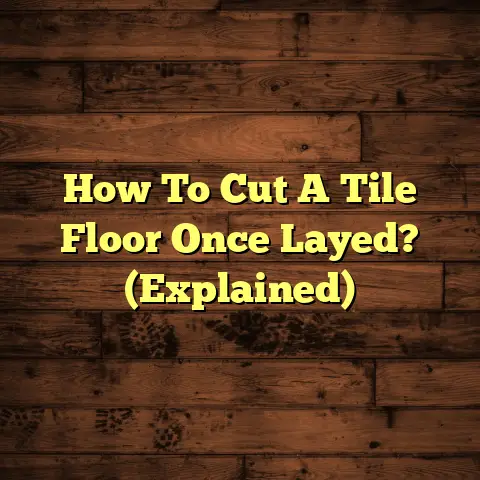Concrete Floor Cracks: What To Know? (7 Signs of Issues!)
(7 Signs of Issues!)
I’m your friendly neighborhood flooring contractor, and today we’re diving deep into the world of concrete floor cracks.Now, I know what you might be thinking: “Cracks? That sounds like a nightmare!” And you’re not entirely wrong.
But understanding these cracks, recognizing the early warning signs, and knowing how to address them can save you a ton of headaches (and money!) down the road.
Introduction: The Importance of Layering
in Concrete Flooring
Think of a concrete floor like a delicious layered cake. You’ve got your base, your filling, and your frosting, all working together to create something amazing.
In concrete flooring, these layers typically consist of the subfloor (the foundation), the base layer (often gravel or compacted soil), and the final concrete layer (the part you see and walk on).
Each layer plays a crucial role in providing structural integrity and durability. A poorly prepared subfloor, for example, can lead to uneven settling and, you guessed it, cracks in your beautiful concrete surface.
I’ve seen it happen countless times. A rushed job during the layering process can compromise the entire floor’s performance. It’s like using cheap ingredients in that cake – the end result just won’t be as satisfying, or long-lasting.
Section 1: Understanding Concrete Floor Cracks
1. Definition of Concrete Cracks
So, what exactly are concrete cracks? Simply put, they’re fractures or separations in the concrete material.
Concrete, despite its tough appearance, is actually a relatively brittle material. It’s strong under compression (when something is pushing down on it), but weaker under tension (when something is pulling it apart).
Over time, various factors like temperature changes, moisture fluctuations, and structural loads can put stress on the concrete, eventually leading to cracks.
Think of it like bending a paperclip back and forth – eventually, it’s going to snap. Concrete is similar, just on a much larger scale.
2. Types of Cracks
Now, not all cracks are created equal. There are several different types, each with its own causes and characteristics. Let’s take a look at some of the most common ones:
-
Shrinkage Cracks: These are the most common type. They occur as the concrete dries and shrinks during the curing process. They’re usually hairline in width and can appear randomly across the surface. I often see these soon after a new pour.
-
Settlement Cracks: These happen when the soil beneath the concrete shifts or settles unevenly. They can be wider than shrinkage cracks and often run diagonally. Seeing these often means there’s a bigger issue to address.
-
Heaving Cracks: These are caused by the ground beneath the concrete expanding, usually due to freezing and thawing cycles. They can cause the concrete to lift and crack. I’ve seen these be particularly bad after a hard winter.
-
Surface Cracks: These are shallow cracks that only affect the surface of the concrete. They can be caused by things like improper finishing techniques or rapid drying. These are usually cosmetic, but should still be addressed.
Knowing the type of crack is the first step in determining the severity of the problem and the best course of action.
Section 2: The Significance of Recognizing Cracks Early
1. Potential Risks
Ignoring cracks in your concrete floor is like ignoring a toothache – it might not seem like a big deal at first, but it can quickly escalate into a much more serious problem.
One of the biggest risks is safety. Cracks can create tripping hazards, especially for children or elderly individuals. I’ve seen minor falls turn into serious injuries because of neglected cracks.
Furthermore, cracks can allow water to seep into the concrete, which can lead to further damage. This water can freeze and thaw, expanding and contracting within the crack, making it wider and deeper over time.
In severe cases, cracks can even compromise the structural integrity of your building, especially if they’re related to foundation issues. It’s always better to be safe than sorry.
2. Economic Impact
Let’s talk money. Dealing with concrete floor cracks can have a significant economic impact. The longer you wait to address them, the more expensive the repairs will become.
Small cracks can often be repaired relatively easily and inexpensively with patching compounds or epoxy injections.
However, if you let those cracks grow and worsen, you might be looking at more extensive repairs, such as concrete resurfacing or even complete floor replacement. I’ve seen costs jump from a few hundred dollars to several thousands simply because of procrastination.
And don’t forget about property value. Cracked concrete floors can be a major turnoff for potential buyers. A well-maintained floor, on the other hand, can significantly enhance the appeal and value of your property.
According to a 2023 survey by the National Association of Realtors, homes with visible structural issues, including cracked foundations and floors, sell for an average of 10-20% less than comparable homes in good condition. That’s a hefty price to pay for neglecting a few cracks!
Section 3: 7 Signs of Issues with Concrete Floor Cracks
Alright, let’s get down to business. Here are seven signs that your concrete floor cracks might be indicating a more serious problem:
1. Sign 1: Hairline Cracks
Hairline cracks are those tiny, spiderweb-like cracks that often appear on the surface of concrete. They’re usually less than 1/16 inch wide.
While they might seem harmless, they can be an early warning sign of underlying problems. They often indicate shrinkage as the concrete cures, but can also be a sign of stress.
I always tell my clients to monitor hairline cracks closely. If they start to widen, lengthen, or multiply, it’s time to investigate further.
2. Sign 2: Wide Cracks
Wide cracks, generally considered to be 1/4 inch wide or greater, are a much more serious concern. They often signify structural problems or significant settling.
Measuring the width of cracks is crucial. You can use a crack width gauge, which is an inexpensive tool that allows you to accurately measure the width of a crack.
If you find wide cracks, don’t hesitate to seek professional help. A structural engineer or experienced concrete contractor can assess the situation and recommend the appropriate repairs.
3. Sign 3: Cracks with Displacement
Cracks with displacement are cracks where the pieces of concrete on either side of the crack are no longer level with each other. One side might be higher or lower than the other.
This is a clear indication of significant movement or settling in the foundation or soil beneath the concrete.
I’ve seen this happen when homes are built on unstable soil or in areas prone to earthquakes. Displacement cracks require immediate attention, as they can compromise the structural integrity of your building.
4. Sign 4: Cracks in Specific Patterns
The pattern of cracks can also provide valuable clues about the underlying cause. Here are a couple of common patterns to watch out for:
-
Stair-Step Cracks: These cracks follow the mortar joints in brick or block walls. They often indicate foundation settlement or movement.
-
Diagonal Cracks: These cracks run diagonally across the floor or wall. They can be a sign of structural stress or shear forces.
Recognizing these patterns can help you narrow down the potential causes and determine the best course of action.
5. Sign 5: Cracks with Water Leakage
Cracks that are accompanied by water leakage are a major red flag. Water intrusion can exacerbate existing cracks and lead to further damage, such as corrosion of reinforcing steel and mold growth.
I once inspected a basement where water was pouring through a crack in the foundation wall. The homeowner had ignored the crack for years, and the resulting water damage had caused extensive mold and rot.
If you notice water leaking through cracks, address the problem immediately. You might need to seal the cracks, improve drainage around your foundation, or even install a sump pump.
6. Sign 6: Cracks Accompanied by Other Signs
Cracks don’t always appear in isolation. They might be accompanied by other signs of structural issues, such as:
-
Bowing Walls: Walls that are leaning inward or outward can indicate foundation problems.
-
Uneven Floors: Floors that are sloping or sagging can be a sign of settling or heaving.
-
Sticking Doors or Windows: Doors and windows that are difficult to open or close can be a sign of structural movement.
It’s important to look at the bigger picture and consider all the signs and symptoms when assessing the severity of concrete floor cracks.
7. Sign 7: Cracks in New Concrete
Finding cracks in newly poured concrete can be particularly concerning. While some minor shrinkage cracks are normal, excessive cracking in new concrete can indicate problems with the installation process, such as:
-
Improper Mix Design: Using the wrong proportions of cement, water, and aggregate can lead to cracking.
-
Poor Curing Practices: Concrete needs to be properly cured (kept moist) for several days after pouring. Failure to do so can result in cracking.
-
Inadequate Subgrade Preparation: A poorly prepared subgrade can lead to uneven settling and cracking.
If you notice cracks in new concrete, contact your contractor immediately. They should be able to identify the cause of the cracking and recommend the appropriate repairs.
Section 4: Conclusion: The Road Ahead
So, there you have it – seven signs of issues related to concrete floor cracks. Remember, vigilance is key. Regularly inspect your concrete floors for signs of distress. Don’t ignore even the smallest cracks, as they can be an early warning sign of more serious problems.
Take proactive steps to identify and address cracks to maintain the integrity of your flooring and, by extension, your property. A little bit of preventative maintenance can save you a lot of time, money, and stress in the long run.
It’s like that saying goes, “A stitch in time saves nine.”
Call to Action:
Now, I’d love to hear from you. Have you ever dealt with concrete floor cracks? What were your experiences? Share your stories and concerns in the comments below. Let’s start a conversation and learn from each other!





